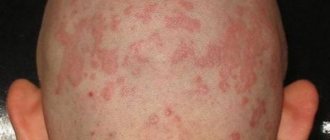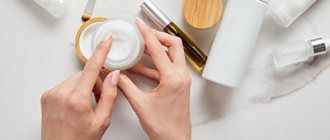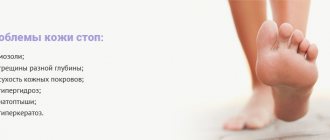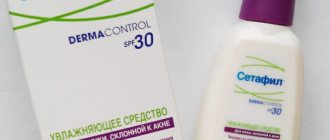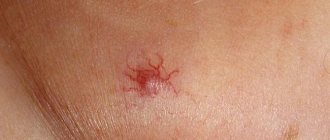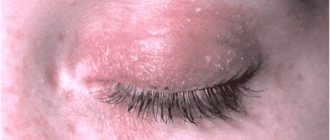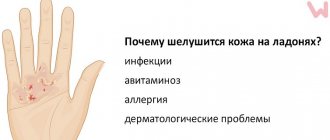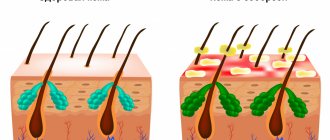Quick transition Treatment of cutaneous lupus erythematosus
Systemic lupus erythematosus is treated by a rheumatologist. During therapy with antimalarial drugs (hydroxychloroquine, chloroquine), observation by an ophthalmologist is necessary. If you suspect the development of squamous cell skin cancer against the background of discoid lupus erythematosus, consultation with an oncologist is necessary.
Lupus erythematosus rashes on the skin and/or mucous membranes can be an independent disease or a manifestation of systemic lupus erythematosus, a chronic disease associated with the formation of antibodies to components of cell nuclei. Antibodies cause damage and inflammation of various tissues, including the skin.
Causes of peeling - external factors and improper care
So, what are the causes of peeling skin on the face? There are three skin types: oily, normal, dry. People with dry skin suffer from flaking more often than others. This is natural. However, if the situation worsens over time, you should pay attention to the following factors.
why does the skin on my face peel?
One of them is lack of moisture in the body. Winds, frosts, scorching sun, dry indoor air during the heating season - all this dries out the skin, causing it to peel. Therefore, such environmental influences should be avoided in every possible way and skin care should be strengthened.
When caring for your face, it is important to remember that excessive frequent washing (especially with hot water), as well as the use of soap products, can negatively affect the skin, causing dryness and irritation.
If by leaving you have achieved the opposite effect, do not despair! Replace regular soap with a skin moisturizer and use a nourishing cream. This will help your facial skin recover.
Also, refrain from rubbing your skin after washing your face. It could hurt her. Better to gently pat your face dry with a soft towel.
Lack of vitamins
The lack of vitamins in the body or their deficiency also leads to flaking of the skin. What should you do in such a situation? It is necessary to help the body accumulate nutrients. To do this, include more fruits in your diet (especially during the period of autumn-spring vitamin deficiency).
Allergy
Peeling of the facial skin often occurs as a result of an allergic reaction to the lanolinic acid contained in face washes. Flowering plants, allergenic foods, and medications can also cause a skin reaction.
If the problem is with your cleanser, you should seek professional advice. If the itching persists, do not delay visiting your doctor. Since this phenomenon may not be a simple irritation, but a symptom of an infectious skin disease.
Dry skin
As we have already noted, the main problem of the skin is the lack of moisture. How to solve it? You should stop using soap when washing your face. It is recommended to replace it with soft, cleansing, non-alcohol-containing products, such as:
- foams,
- mousses,
- gels.
causes of peeling skin
Symptoms
The skin manifestations of lupus erythematosus are diverse. A significant manifestation, almost always associated with a systemic disease, is a rash on the face, shaped like a butterfly: with wings on the cheekbones and cheeks and a body on the bridge of the nose and bridge of the nose. The rash may appear as raised or deep-lying elements of pink and bluish-red color. There is a tendency to form ring-shaped lesions covered with very dense scales that are painful when removed. In some cases, the so-called lupus erythematosus pernio is formed, in which painful bright red bluish nodules appear on the toes, hands, nose, and ears in cold weather. Damage to blood vessels is accompanied by the appearance of rashes resembling bruises; dilated vessels can be visible in the nail beds. Some patients with SLE have symptoms resembling lichen planus.
There are also severe lesions with the formation of blisters and peeling of the skin, which is more typical for the onset of a systemic disease. Changes can affect the mucous membranes, especially often the mucous membranes of the lips and oral cavity. Lupus lesions on the scalp may result in hair loss. Diffuse hair loss and hair thinning are also possible.
"Panthenol"
An effective remedy for protecting against flaking of facial skin is the drug “Panthenol”. Particularly convenient to use thanks to the spray form. This drug is sprayed onto problematic facial skin; after a few minutes, the remaining drug must be removed with a cotton pad. The drug can be used up to four times a day. The use of Panthenol stops the inflammatory process, relieves skin irritation, and eliminates flaking. The drug softens and restores problematic facial skin.
why does my face itch
Treatment of cutaneous lupus erythematosus
The basis of treatment is corticosteroid hormones. With this disease, they can be applied to the lesions in the form of ointments, or injected directly into the lesion of the affected skin. In severe cases, systemic corticosteroids may be prescribed. As an alternative or to enhance therapy, it is possible to apply calcineurin inhibitors to the lesions.
In cases of severe skin damage and insufficient effect of external treatment, systemic therapy is carried out using antimalarial drugs (chloroquine, hydroxychloroquine), anti-inflammatory drugs (methotrexate, mycophenolate, dapsone, azathioprine, etc.).
Features of the treatment method
The first line of treatment is topical corticosteroids and hydroxychloroquine.
To reduce the total dose and side effects of topical corticosteroids, calcineurin inhibitors are included in treatment.
During treatment with hydroxychloroquine, regular medical supervision is necessary. The condition of the retina must be monitored, since the drug can impair vision with long-term (more than 5 years) use. This side effect is uncommon, but signs of retinal damage may require discontinuation of the drug.
Intralesional administration of drugs (corticosteroid hormones) using multiple superficial injections directly into the lesion of the affected skin allows you to create a high concentration of the drug in the lesion, while reducing the risks of systemic side effects. The medicine is administered by a doctor in a dressing room to a depth of 2-3 mm. The procedure is painful, but the pain is not sharp and largely depends on the sensitivity of the patient’s receptors. To reduce pain, a thin needle is used, and an anesthetic ointment may be used.
All patients must be prescribed skin protection against ultraviolet radiation.
How is lupus erythematosus treated at the Rassvet clinic?
The dermatologist will ask you to talk about the course of the disease and the treatment that was carried out previously. The doctor will examine the skin (including the scalp) and mucous membranes. Dermatoscopy and trichoscopy can be informative. With this disease, to establish a diagnosis in most cases, a skin biopsy will be required with an additional immunofluorescence reaction.
If cutaneous lupus erythematosus is suspected, it will be necessary to discuss the possibility of systemic manifestations and assess the condition of other organs and systems of the body. Additional studies may be required to identify a systemic process (blood tests, urine tests, etc.).
What are red spots on the face?
Red spots appear on various parts of the facial skin. By assessing the location, type and additional symptoms, a preliminary diagnosis can be made.
Localization
In some diseases, red spots are localized in certain areas:
- nose - allergies, infectious diseases, demodicosis, fungal diseases, rosacea, lupus erythematosus, stress, hormonal imbalance and others;
- chin - allergies, rosacea, scleroderma (connective tissue disease), irritation, hormonal imbalance and others;
- cheeks - allergies, rosacea, rosacea, lupus erythematosus, infectious diseases, elevated body temperature, smoking, alcohol consumption, poor diet, diseases of the vascular system and others;
- forehead - seborrhea, allergies, red versicolor, irritation, rosacea and others;
- area around the eyes - irritation, inflammatory diseases of the eye sockets, kidney disease, fatigue, hypertension and others;
- near the mouth - allergies, helminthiasis, gastrointestinal diseases, fungus, infectious diseases, herpes and others.
Appearance: Spots may peel or become wet
In some diseases, red spots can form on any part of the face and even spread throughout the skin. Therefore, it is necessary to take into account the appearance of the stains.
- dryness, peeling, tightness - allergic reaction, dehydration, chapping, burn;
- weeping spots - eczema, dermatitis;
- raised spots - subcutaneous acne, vitamin deficiency, infectious diseases, fungi;
- swelling - inflammation, ripening pimple;
- swelling - kidney disease, allergies, diathesis;
- pus - inflammation, purulent pimples, severe form of fungus.
Symptoms
The appearance of red spots can be accompanied by a number of unpleasant signs. Most often there is a burning sensation, itching or pain. In addition, the spots may itch and peel.
However, you should not give in to temptation and scratch them, since damage to the skin can aggravate the situation. The listed signs often indicate the presence of skin diseases. A feeling like your face is on fire indicates high blood pressure.
Nature of manifestation of irritation
Red spots can be acute or chronic, depending on the cause. In the presence of chronic diseases, red spots appear periodically or do not leave the skin.
Temporary redness goes away after a few days or weeks and usually does not return.
Manifestation during neurointoxication
Neurointoxication due to poisoning or infection will also be stressful for the heart. The symptom of a white spot with shock of the 3rd degree will also be observed. In addition, there will be other noticeable symptoms:
- confusion;
- reduced temperature;
- broken sinus rhythm of the heart - bradycardia;
- intestinal paresis;
- skin cyanosis.
First aid for severe intoxication is to induce vomiting. And immediately call an ambulance.
Eczema is a chronic, skin, non-contagious, inflammatory disease characterized by rashes, itching, periods of exacerbation and remission (improvement).
Another name for eczema is tinea versicolor. Translated from ekzeo - to boil, this explains the property of bubbles to quickly open, like bubbles of boiling water.
The disease itself is widespread.
There are two forms of eczema: acute and chronic.
There are the following types of eczema:
- The true (idiopathic) form is characterized by an acute onset of the disease. The lesion is symmetrical (most often the hands are involved, but can be located anywhere), the boundaries are unclear. Foci of redness are noted, against which vesicles (bubbles), papules (nodules) form, the skin is swollen; after some time, the blisters open, forming erosions (skin defect), serous contents are released (called eczematous wells) - this condition is called oozing, then the contents dry out and serous (if the contents are serous) or hemorrhagic (i.e. bloody) crusts are formed.
- Microbial eczema develops at the site of chronic foci of infection; when an infection is attached, the following subtypes can be distinguished.
Mycotic form - when a fungal component is attached, peeling occurs.
Paratraumatic form - rashes are located at the site of injury.
Varicose form - against the background of trophic disorders, most often located on the legs, rashes of a bluish-purple color, located asymmetrically.
Treatment of pathology
A spot on the palm or other part of the body requires adequate treatment. The doctor selects the therapy after receiving the diagnostic results. Treatment must be comprehensive. Traditional therapy is recommended for use in combination with medications.
Additionally, you definitely need to reconsider your lifestyle
This is an important condition for successful recovery.
Drug therapy
Drug treatment is the most effective. Therapy is aimed at eliminating the underlying cause of symptoms. Drugs are prescribed based on the main diagnosis.
The patient may be advised to use:
- ointments, creams;
- drugs in tablet form;
- lotions;
- vitamin complexes.
Additionally, the patient is prescribed cosmetic procedures. Cryomassage, clay therapy, and electrocoagulation have shown high effectiveness. They help eliminate cosmetic defects in the form of rashes.
Treatment depends on the diagnosis:
- antihistamines are prescribed for allergies;
- antimycotic therapy is prescribed for fungal infections;
- Antibacterial medications are needed for bacterial infections.
If clinical signs are highly intense, as well as a sudden onset of symptoms, you should urgently call an ambulance.
Traditional treatment
Traditional methods speed up the healing process. Reduce the severity of symptoms.
The following are considered effective:
- lotions made from birch bark tincture;
- decoction of celandine;
- ice cubes from parsley decoction.
Traditional methods are selected depending on the diagnosis. You must first consult a doctor.
Correction of nutrition and basic hygiene
When you are sick, you need to reconsider your lifestyle. All harmful foods are excluded from the diet. Confectionery products, soda, sauces, canned food, semi-finished products, fast food, and sausages are strictly prohibited. Nutrition should be balanced. It is necessary that food intake is fractional. It's better to eat less, but more often. All allergens, such as chocolate and citrus fruits, are temporarily excluded from the diet. The patient should drink plenty of clean water.
The patient must give up bad habits. Drinking alcohol and smoking are prohibited.
You need to take care of personal hygiene. The patient should use only gentle detergents when bathing. After a shower, dry yourself with soft towels. It is temporarily advisable to completely stop wearing synthetic clothing.
